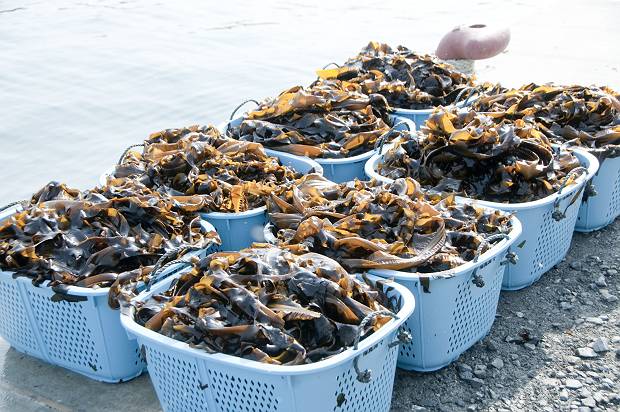
Activity Reports
For Lasting Support! Fishing Experience Program – 2nd day of Wakame seaweed harvesting
April 9, 2012
The first fishing experience programme was held in Sudachi/Fukiura, Ojika Peninsula. The first day was action packed, ranging from an excursion to the Ishinomaki Fish Market, trying gill net fishing, removing oyster shells, a study tour around the community, and exchange with the local fishermen, while the second day was Wakame seaweed harvesting offshore! Participants also participated in workshops entitled “considering the future of the fishing village.” Although the progra,,e was only one night and two days, participants absolutely fell in love with Sudachi/Fukuira. This programme is a new initiative in uncharted territory of “volunteering,” which we hope will provide an opportunity for many people to consider the future of fishing villages in the Tohoku area.
The below entry is written by one of the participants of the programme.
5:20am Getting Up
Rubbing our sleepy eyes and withholding our eagerness, we prepared ourselves for onboard works and rushed to the port.
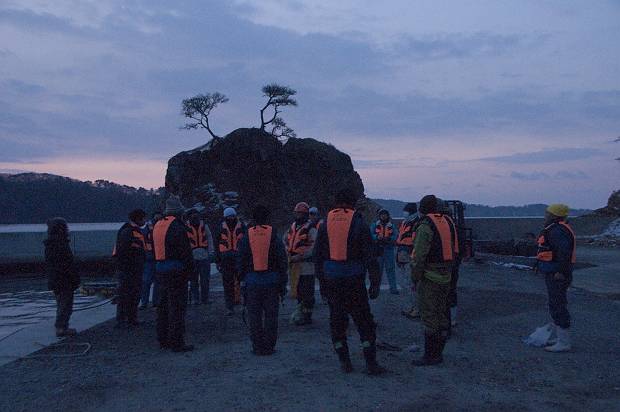
6:10am Off to harvest the Wakame seaweed
Blowing away the nipping air, high-spirited voices of fishermen were echoing through the port. Leaping onboard and sailing offshore against the icy wind for 10 minutes, we arrived at the Wakame seaweed farming site where buoys with printed trade names were neatly arranged.
In contrast to the gill net fishing of the previous day, the Wakame farming site was situated out in the open sea with rough waves. Staggering with pitching and rolling motion of the boat, we harvested Wakame seaweed grown densely over thick rope. Although our hands had completely lost the grip from icy water and wind, everybody was focused and giving their best.
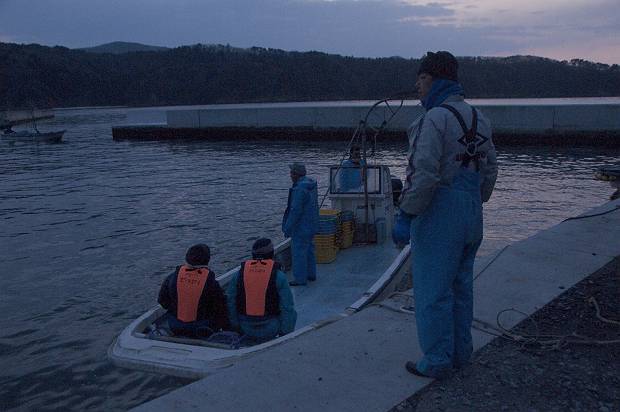

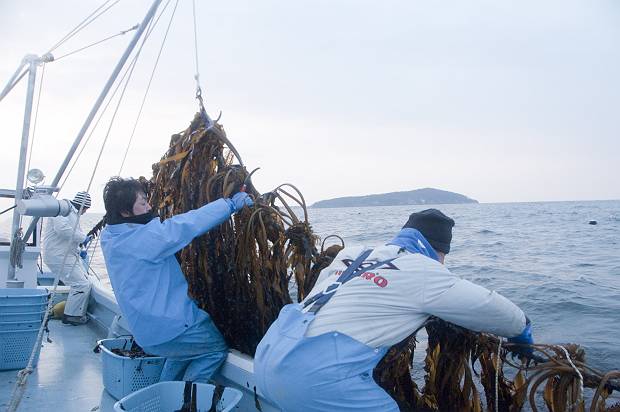
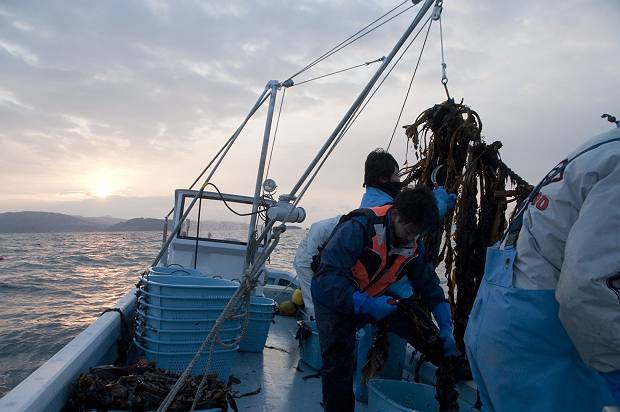

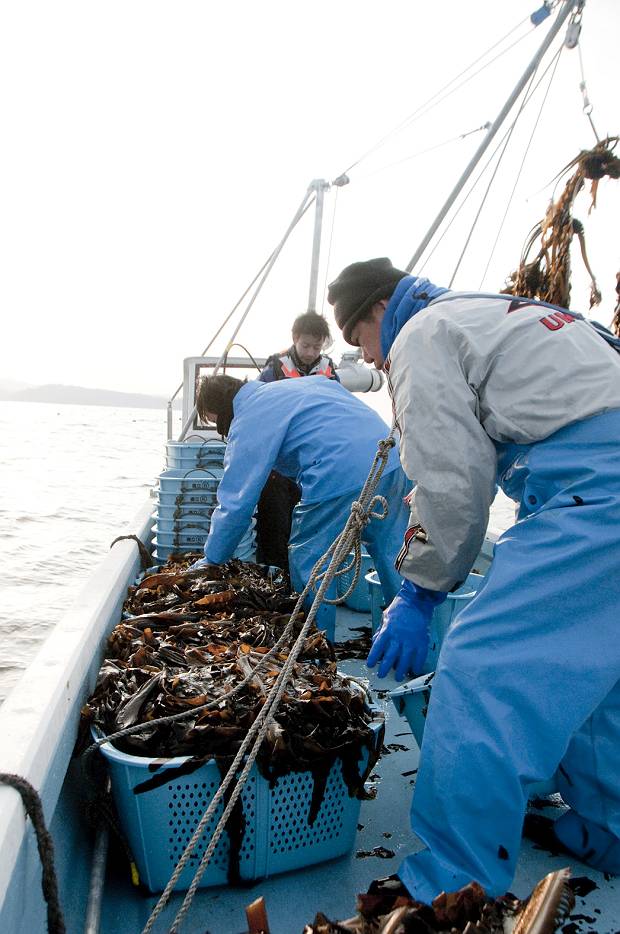
10:45am Returning to the port
We returned to the port with loads of Wakame. It was quite an effort to bring Wakame filled baskets up on the shore.
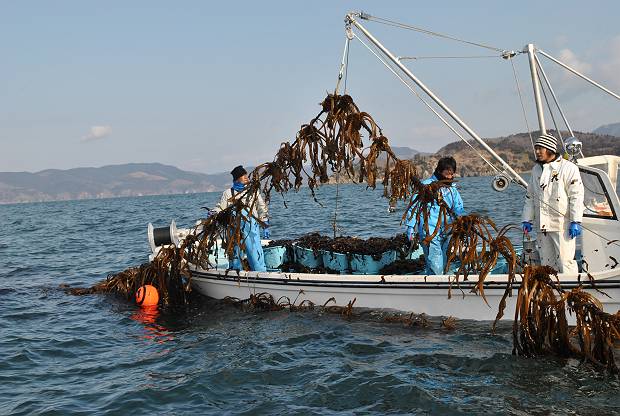
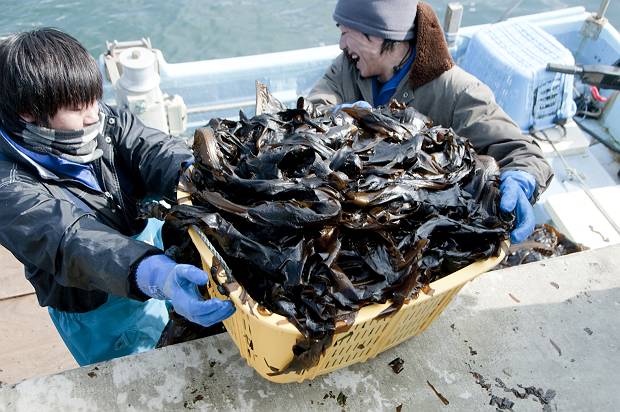
10:55am Selling
Once on the shore, the buyers and fishermen weighed the harvest together. Weighed Wakame seaweed is then thrown into a tank.
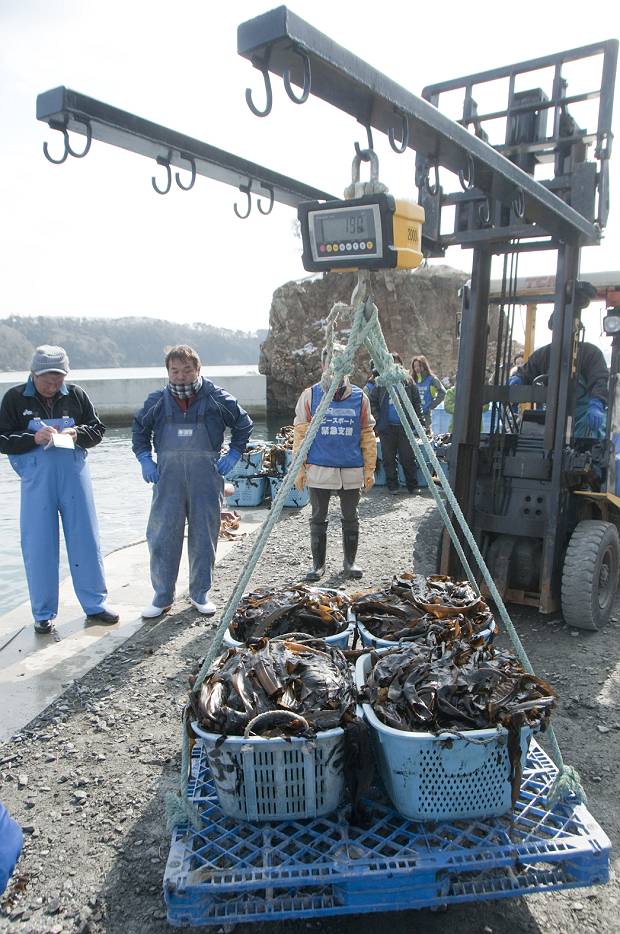
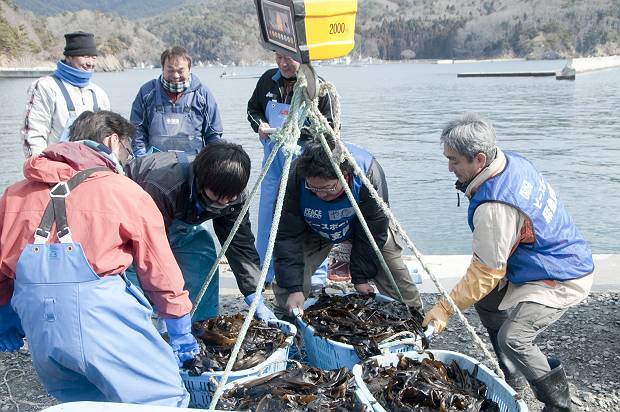
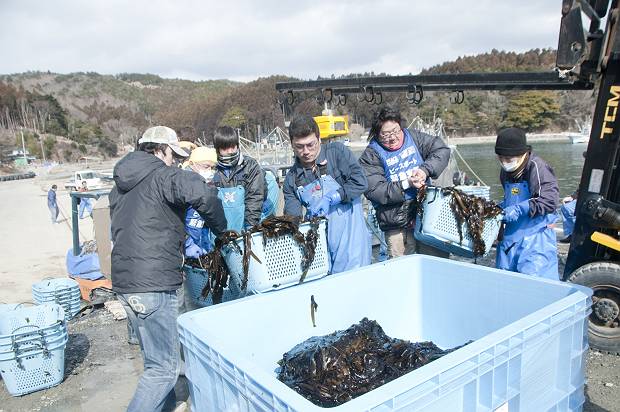
11:55am Slicing off Mekabu
Slicing off Mekabu (kelp meal), pleats at the root of Wakame seaweed. Using a special Y-shaped knife designed for the work, the mekabu part is sliced smoothly off. It feels so good when slicing goes well!
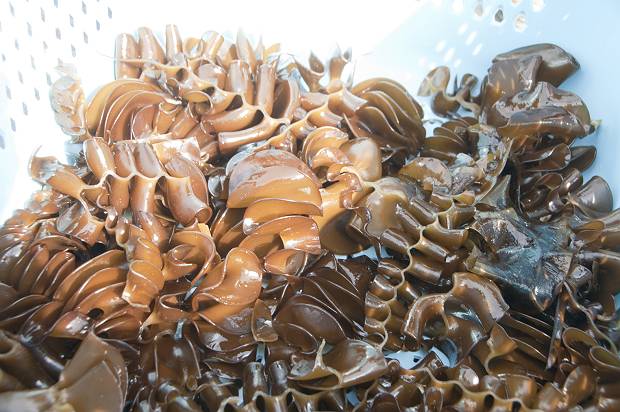
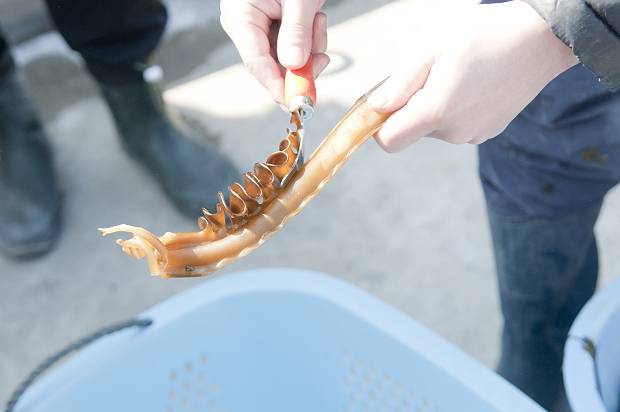
12:30pm Lunch
We learned how to make a local dish using Mekabu just being sliced off. It is so simple, yet so tasty! Highly recommended!!
- Mekabu Dish a la Sudachi Fishermen -
1. Chop up Mekabu according to your taste, place in a strainer, and pour boiling water over it.
2. Then place it in a bowl and mix with finely chopped naganegi onion.
3. Pour some men-tsuyu (sauce for Japanese style noodles). Bon apetit!!
13:15pm Aranami Oyster Bite-size Ownership application
Mr Ishimori insisted repeatedly, “I don’t want to force them!! Only if they want to support the reconstruction of oyster processing plant, then they should apply. Only if.”
It turned out that most of the participants applied. Thank you everyone for your support.
Tasty oysters will be delivered to their homes as soon as the reconstruction is done.
Wait till then!!
14:00pm Leaving Sudachi
Even thought the programme was only for a night and two days, participants fell absolutely in love with Sudachi/Fukiura. It was hard to leave. It was so touching to see everyone from the village coming out to see us off.
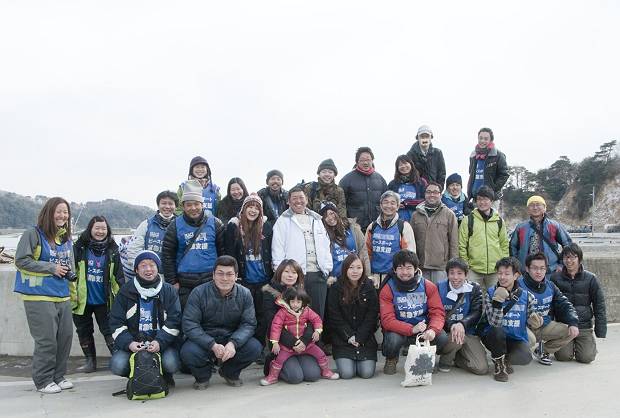
14:30pm Excursion to Onagawa & Minamihama
15:30pm Arriving at the volunteer shelter & cleaning up
16:35pm “Considering the future of the fishing village” workshop
This is a workshop to brainstorm about how volunteers can continue long-term support, by sharing our reflections and thoughts from the experience of the past couple of days. It is the most important part of the program in order for it to be truly meaningful and continuing, rather than merely being a one-off “volunteer experience” or “fun fishing experience”.
In the first half, each participant shared their thoughts, and in the latter half, they engaged in group discussions about “current challenges faced by the village” and “what will be needed, and how we could help” and shared what was discussed.
-Thoughts of participants-
- I felt strongly the drive of people for self-reliance and reconstruction. I saw needs for financial support, so I would like to share this with my community.
- Once again, I am convinced of the importance of damage mitigation.
- When I saw the fish market, I thought the reconstruction was underway. But when I saw the reality of the village and heard that oyster processing plant is not yet in place, I realised that there is still a long way ahead.
- I didn’t come as a so-called volunteer, so I felt a little uncomfortable being welcome to such extent. But I am grateful for being able to have such meaningful time as never before.
- Observing the work of fishermen, now I understand how tough their job is.
- Fooling around with the fishermen, and seeing them as human being, I felt connected. It was also great to have a firsthand experience of their job.
- I felt baffled with too much hospitality. It was great to know that they really appreciate the volunteers.
- Now I know that fishermen spend everyday thinking of their next moves.
- I am very grateful for the hospitality of Sudachi/Fukiura fishermen. I would like to give something back to them someday.
- It was great to meet people and have heartfelt communication.
- I could see the reality from the perspective of the locals. I would like to share this with many people.
- I understood the importance of the oyster processing plant. I would like to tell people around me about the bite-size ownership programme.
- I felt quite moved to see that now they are shifting into a phase of intellectual work from physical work.
- Though Mr Ishimori had a smile in his face when talking, he seems to be carrying a burden, and he has no choice but to cope with that.
- It is important not to forget and to visit again.
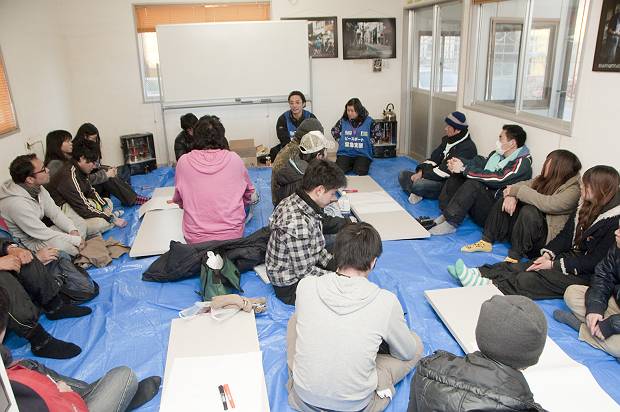
“Current challenges” and “future support” (group presentation)
- Migration away from the area and lack of successors
Peace Boat coordinating staff Kobayashi Shingo’s comment: Ishinomaki has the third greatest outflow of population in the Tohoku region, with 4,000 people having died or missing, and about 5,000 relocated outside the prefecture. The city had been experiencing hardships because of its population aging or migration away from the area even before the disaster.
- No source of income other than fishery and aquaculture → More options may be needed.
Peace Boat staff Saza Shinsuke’s comment: It is very difficult to have employment other than within the fishing and aquaculture industries, especially considering cultural aspects.
- Little marketing of Aranami Oyster, Wakame seaweed, etc.
Saza: The main concern of fishermen is to be able to say “I caught the most!”’ Most are not concerned about other aspects (e.g. marketing). On the other hand, there are some who are trying something new including using blogs, iPads, and Facebook.
Participant: “Branding” is important. “Sudachi” or “from the disaster-affected areas ” is in a way a kind of originality. We need some effort to turn this into an added value.
Saza: Quality is important for branding. There will be more complex standards to meet. “Above this standard can be shipped out, the ones below cannot.” etc.
Participant: Branding doesn’t necessarily mean “creating a brand”. It is about doing something so that people would want a certain item specifically.
Participant: How about building a booth in a supermarket and alike, so that people can try the oysters at a reasonable price with ease>
Participant: Why not coming up with a new and delicious oyster recipe?
- Lack of oyster processing plant
=> spread the bite-size ownership system.
Kobayashi: I believe that people support the ownership because they have come and witnessed the local reality themselves. Given that not too many people can actually come, how can we spread the word?
Participant: A friend of mine is holding a photo exhibition to incur people’s interest in the disaster affected areas.
Kobayashi: This kind of idea doesn’t come from the fishermen. We need perspectives from outside.
Participants: Would it be possible to continue this bite-size ownership for a few years longer?
Kobayashi: That’s a good point, particularly because there would be less and less attention from people as time passes.
Saza: The ownership generates revenue. For this very reason, it is worth continuing.
Kobayashi: We could send an invitation for a second round of ownership when we ship out the oysters.
- Food safety
=> Check thoroughly for radioactivity.
Kobayashi: This is a deep rooted problem. It is important to be able to check accurately, and reassure of safety. Many people don’t trust the standards and figures provided by the government. So we may need to think of doing our own monitoring. But if the figures goes beyond limits, the community will not be able to ship out the harvest.
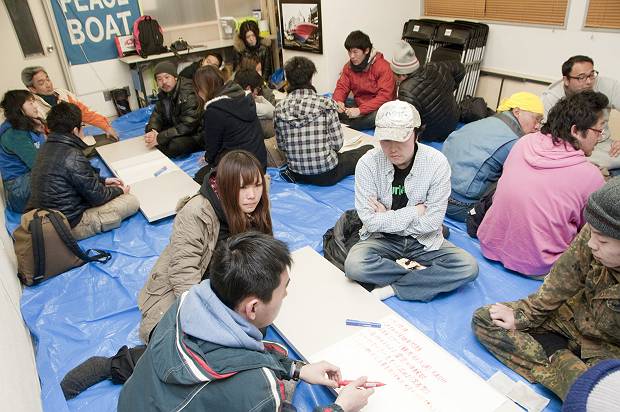
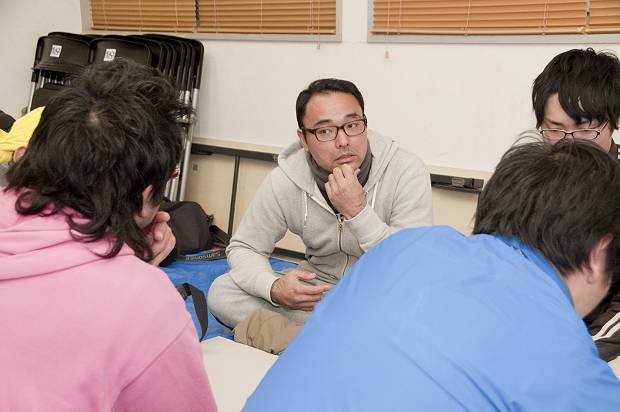

Finally, a message to all the participants from the Peace Boat staff who coordinate this programme – Kobayashi Shingo, Saza Shinsuke and Okumura Sanae.
Kobayashi: They may no longer need hands. But I would like to cherish this encounter in order to think of our course of future action. The exact nature may change, however I would like to continue the fishing experience program.
Saza: I believe that many were baffled with too much hospitality, including myself. Some might have felt that “they couldn’t be of any help at all”. But if they were to be of help, then it would be after this programme is over. It would be great if we could be “of their help” into the future by thinking what each one of us here can do, connecting with each other after the programme, and then staying connected with the locals here. These two days are just the beginning.
Okumura: I want as many people as possible to become “Sudachi/Fukiura Fans”. I believe that something great will happen from the network of these fans. I would like everyone who came here to remember the taste of the Aranami oysters and come back again.
18:55pm Dinner
20:30pm Departure
Though I participated as a reporter this time, I became enchanted by Sudachi/Fukiura in only two days. The taste of the juicy Aranami oysters and Wakame shabu-shabu (a Japanese hot pot dish) which I tried for the first time, the enthusiastic face of Mr Ishimori as he spoke about his community, the sunrise seen from the boat cutting through the rough waves, and above all the heartfelt communication beyond words with the local fishermen. I will never ever forget Sudachi/Fukiuwa even if I leave Ishinomaki one day.
At a later date, I received an email from a fisherman who I met at the exchange party.
“Thank you for coming and your work. I am filled with sense of gratitude whenever I see our community and city slowly being reconstructed. Please come by in a little while for sightseeing and all like normal.”
If it were not for the disaster, I would have never met these people, and I would have never come to this place. Yet, now I find myself feeling this place as “my second home” rather than just “a place I came to volunteer”, wondering “what I can do for these people”, and wanting to “come back for sure”.
Now that the number of problems which can be solved through extra pairs of hands or workforce is decreasing, the presence of more people with similar sentiments will lead to continuing support and then to further reconstruction.
The fishing experience programme will be continued in April and after, in different places and in different styles. We invite you all to experience the life of fishermen, meet with them, and think of next steps to support together!




